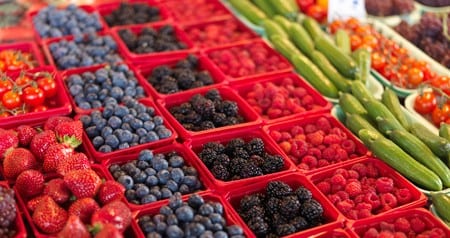Brought to you by the First Coast YMCA
The eating and activity habits we develop as children have a strong impact on our lifelong health and well-being. Whether we grew up with healthy habits or not, it’s our obligation as grown-ups to ensure kids have a strong foundation.
With so much information and so little time to plan and prepare, it can seem that eating healthy is a nearly impossible task in today’s world. It’s tough to make dramatic change overnight, but with a commitment to trial, transition and a few tricks, families can adopt healthier habits happily.
Aim for Five Every Day
The delicious crunch of fruits and veggies should be part of every meal your family enjoys throughout the day. Stay healthy by reaching for five servings per day.
Your local farmers’ market or the produce aisle in your grocery store is full of interesting shapes, textures and colors inviting youthful exploration. Make trying new things fun by building a “real foods” adventure into your trips to the market or the produce section. Involve the kids in the process and watch their willingness to try new things grow and flourish.
Choose Your Drinks with Care
A simple way to improve the overall health of your family is to adjust your approach to fluids. Try cutting out drinks with added sugar and focus on adding more water, 100 percent fruit juice and low-fat milk to your family’s diet.
One of the simplest and most important things you can do for your health is to drink water. The human body is made up mostly of water (about 60 percent), and it relies on water to help perform every function. Make water your first choice every time, especially during warmer seasons and after vigorous physical activity.
Check the Label
By learning to understand the information that all food packages are required to provide, you can begin to make choosing healthier foods a little easier. When shopping, refer to the nutrition facts label.
For children ages 5 to 12, nearly a third of the daily calories in the healthy foods we provide should come from fat. Fat is an essential part of growing and being healthy, and the nutrition facts label can help you steer clear of the fats that are not particularly healthy. Trans fat is one type of fat found in processed foods that you should avoid entirely.
Low-fat dairy products, avocados, no-sugar added peanut butter or almond butter, and modest amounts of foods prepared in olive, canola or peanut oil are healthy options for kids to get the fat they need.
Control Your Portions
Sure, we all overeat from time to time, but by being careful to serve food portions that are aligned with your family’s energy needs is one way to help everyone eat and be healthier.
Studies have shown that using smaller plates can be an effective strategy for reducing the amount of food that your family eats. Our tendency when we serve food is to fill the plate, which often leads to larger portion sizes than we actually need. Consider serving your meals on the salad plates in your family cupboard instead of the larger entrée plates.
If you’re looking for professional support or additional education on healthy eating, look no further. Whether it’s our Healthy Living Centers or nutrition services, First Coast YMCA offers resources and guidance to help local children, adults and families maintain or improve their physical activity, health and wellness.


















